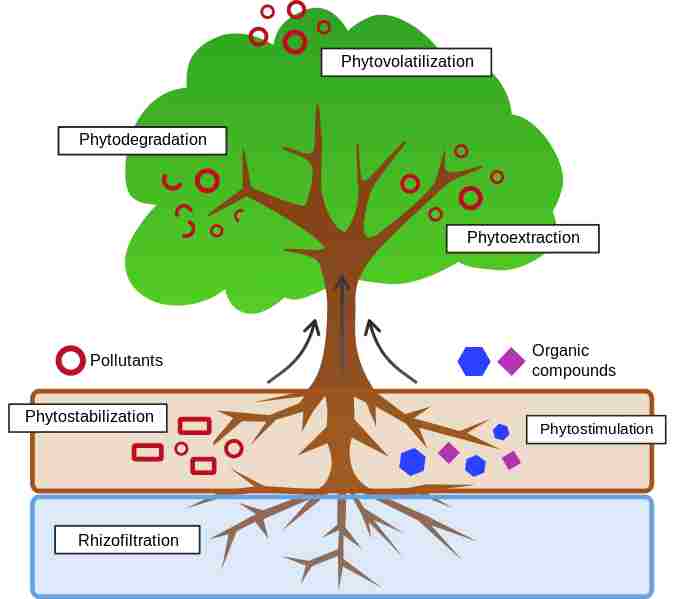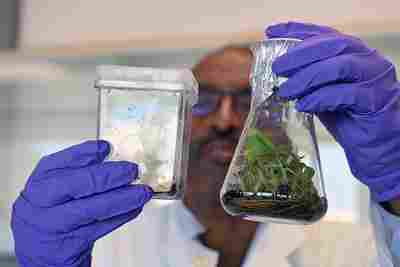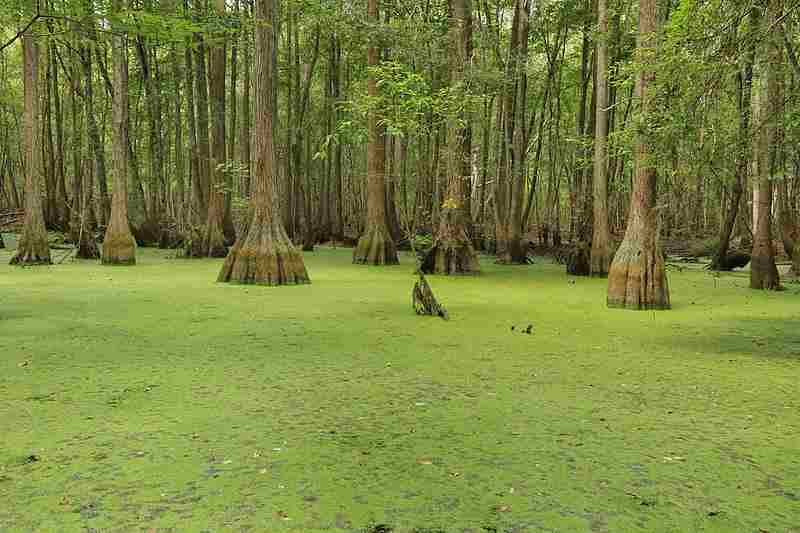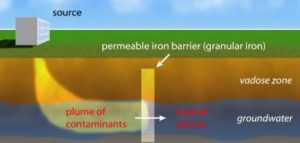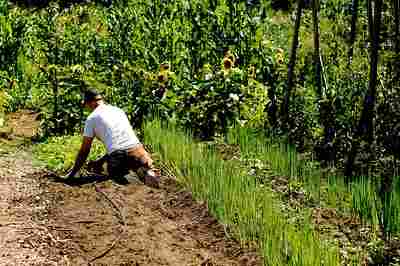7+ Types of Phytoremediation and Their Basic Mechanisms
Types of phytoremediation are; phytoextraction, rhizofiltration, phytotransformation, phytovolatilization, phytohydraulics, rhizodegradation, and phytofiltration.
This article discusses the types of phytoremediation and their basic mechanisms, as follows;
1). Phytoextraction
Phytoextraction, also known as phytoaccumulation or phytosequestration, is a phytoremediation technique that leverages the natural ability of certain plants to accumulate contaminants, primarily heavy metals, from the soil or water into their harvestable biomass.
This process is highly valuable for environmental remediation and sustainable resource recovery. Some of the key aspects of phytoextraction are discussed in this section.
Basic Concept and Mechanism of Phytoextraction
The concept and mechanism of phytoextraction comprise of steps and processes like plant uptake, root mediation, translocation, contaminant storage, and harvesting. They are outlined in a list format below;
Phytoextraction relies on plants that have the capacity to absorb, accumulate, and store contaminants from the surrounding environment.
Contaminants in the soil or water are mobilized in the rhizosphere (root zone) of the plant.
Plant roots take up these contaminants, which are then transported via the plant's vascular system to the aboveground portions, such as leaves and stems.
Contaminants are sequestered and compartmentalized within the plant's tissues, primarily in the aboveground biomass.
The process involves repeated harvesting of the aboveground plant parts, effectively removing the contaminants from the site.
Usability and Suitable Conditions for Phytoextraction
Phytoextraction is best suited for environments contaminated with heavy metals, such as cadmium, lead, copper, and zinc, as well as other elements like arsenic. These environments may include landfills and industrial sites.
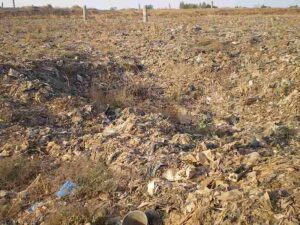
The conditions and procedure for successful phytoextraction include; selection of hyperaccumulator plants, suitable soil and water characteristics, monitoring and management, as well as long-term maintenance. Below is an outline elaborating these factors;
Certain plants, known as hyperaccumulators, are particularly efficient at accumulating high levels of specific contaminants. Choosing appropriate hyperaccumulator species is crucial.
The success of phytoextraction depends on factors like soil pH, nutrient levels, and contaminant concentrations. Soil amendments may be used to optimize conditions.
Continuous monitoring of contaminant levels and sustainable management practices, including controlled harvests, are essential for effective phytoextraction.
Phytoextraction can be a time-consuming process, especially for heavily contaminated sites. Patience and a long-term perspective are necessary for its success.
Advantages of Phytoextraction as One of the Types of Phytoremediation
Advantages of phytoremediation include environment-friendliness, resource efficiency, cost effectiveness, and sustainability. They are further highlighted in the discussion below;
Phytoextraction is a green, eco-friendly method that minimizes the need for excavation and disruption of the site.
This technique can potentially recover valuable metals from contaminated sites, turning a liability into a resource.
Phytoextraction can be a cost-effective remediation method, especially for large-scale contaminated areas.
Also, it promotes the sustainable use of plants to clean up polluted environments, making it a valuable tool in green chemistry.
*Additional Notes on Phytoextraction as A Type of Phytoremediation
Phytoextraction is a phytoremediation technique that involves using plants to absorb and accumulate contaminants, primarily heavy metals, from soil or water into their harvestable biomass.
Other terms used in place of phytoectraction are phytoaccumulation and phytosequestration.
Phytoextraction is used for environmental remediation and resource recovery. It helps remove contaminants, primarily heavy metals, from contaminated soils or water while potentially recovering valuable metals and promoting sustainable practices in green chemistry.

2). Rhizofiltration
Rhizofiltration is a specialized form of phytoremediation that focuses on the use of plant roots to filter and purify contaminated groundwater, surface water, or wastewater by removing toxic substances or excess nutrients.
This process harnesses the unique properties of plant roots for environmental cleanup. An elaborate overview of rhizofiltration is provided in this section.
Basic Concept and Mechanism of Rhizofiltration
The mechanism of rhizofiltration comprises of distinct steps or phases like contaminant uptake, adsorption, and absorption. These are briefly outlined below;
Rhizofiltration involves the uptake of contaminants from the surrounding water by plant roots. Both absorption and adsorption processes occur during this phase.
Contaminants can be adsorbed onto the root surface, where they may be immobilized or precipitated as salts, effectively removing them from the water.
Also, contaminants can be absorbed through the root tissues, where they are transported within the plant.
Usability and Suitable Conditions
Rhizofiltration is effective and most suitable for addressing water-related contamination issues, including the removal of heavy metals, organic pollutants, and excess nutrients like nitrates and phosphates.
Some conditions and factors for which rhizofiltration is best suited include; contaminated water sources, hyperaccumulating and flood-tolerant plants (including hydrophytes), nutrient removal, and long-term treatment with continuous management. The outline below reiterates these factors;
Rhizofiltration is ideal for remediating contaminated groundwater, surface water bodies (such as lakes and rivers), and industrial wastewater.
Selecting appropriate plant species that have a high affinity for the specific contaminants of concern is crucial for the success of rhizofiltration.
In addition to metal contaminants, rhizofiltration is effective for removing excess nutrients like nitrates and phosphates, making it valuable for addressing eutrophication issues.
Rhizofiltration may require continuous monitoring and management, as the effectiveness of the treatment can vary over time.
Difference(s) Between Rhizofiltration and Phytostabilization
Phytostabilization is a different phytoremediation technique that focuses on reducing the mobility and bioavailability of contaminants in the soil rather than removing them from the environment. It involves planting vegetation to stabilize contaminated soils and prevent the spread of pollutants.
The main difference between rhizofiltration and phytostabilization is that rhizofiltration is specifically designed for the treatment of water, while phytostabilization is used for soil remediation.
Difference(s) Between Rhizofiltration and Rhizodegradation
Rhizodegradation is another phytoremediation technique that involves the breakdown of organic pollutants in the soil zone surrounding plant roots, primarily through the stimulation of microbial activities by plant root exudates.
Rhizofiltration focuses on the physical removal of contaminants from water using plant roots and may also involve adsorption and absorption processes.
The key difference between rhizofiltration and rhizodegradation lies in the target contaminants and the mechanism of action; where the former targets inorganic contaminants through physical filtration mechanisms, and the latter targets organic contaminants using biodegradation mechanisms.
Additional Notes and Reiterations on Rhizofiltration; as One of the Types of Phytoremediation
Rhizofiltration is a phytoremediation technique that uses plant roots to filter and purify contaminated water by removing toxic substances or excess nutrients. It involves both the adsorption of contaminants onto root surfaces and the absorption of contaminants into root tissues.
Phytostabilization focuses on stabilizing contaminated soils and reducing contaminant mobility, while rhizofiltration is specifically designed for the treatment of contaminated water.
Rhizofiltration involves the physical removal of contaminants from water using plant roots, while rhizodegradation focuses on the microbial degradation of organic pollutants in the soil zone surrounding plant roots.
3). Phytotransformation
Phytotransformation, also known as phytodegradation, is a type of phytoremediation that focuses on the breakdown and transformation of organic contaminants sequestered by plants. This process involves either the metabolic processes occurring within the plant or the influence of compounds, such as enzymes, produced by the plant.
In this section, some of the key aspects of phytotransformation are highlighted.
Basic Concept and Mechanism of Phytotransformation
The mechanism of phytotransformation involves phases like; organic contaminant breakdown, plant metabolism, release of exudates and enzymes. This mechanism is outlined below;
Phytotransformation primarily targets organic pollutants, aiming to break them down into simpler, less harmful molecules.
Within the plant, metabolic pathways facilitate the transformation of complex organic molecules into simpler forms. These metabolic processes may involve enzymatic reactions.
Some plants release exudates or enzymes into the root zone (rhizosphere), which can enhance microbial and fungal degradation of organic contaminants.
Usability and Suitable Conditions
Phytotransformation is best suited for addressing organic contamination issues, particularly complex organic molecules. Some of the conditions and factors for which phytotransformation is well-suited include organic contaminants, degradation-inducing plant species, rhizosphere enhancement, and contaminated sediments or water bodies.
Phytotransformation is most effective for organic contaminants, including petroleum hydrocarbons, polycyclic aromatic hydrocarbons (PAHs), and other complex organic pollutants.
Selecting plant species that have the capacity to metabolize or facilitate the degradation of specific organic contaminants is critical.
The release of exudates and enzymes into the root zone can significantly enhance microbial and fungal degradation, making the rhizosphere a key focus for phytotransformation.
Phytotransformation can be applied in various settings, including contaminated soils, sediments, and water bodies.
How Phytotransformation Works
Phytotransformation works through a combination of plant uptake, metabolic transformation, microbe stimulation, and bioaccumulation (within plant tissues). These are basically the same phases listed under the mechanism of phytotransformation.
In the first stage, organic contaminants in the soil or water are taken up by plant roots. Within the plant, metabolic processes occur to break down complex organic molecules into simpler forms.
Some plants release exudates or enzymes into the rhizosphere, creating a favorable environment for microbial and fungal activity.
Microorganisms and fungi in the rhizosphere further degrade the transformed organic molecules, aiding in the cleanup process.
In some cases, the breakdown products may be incorporated into the tissues of the plants, after they have been transformed into less harmful substances.
*Additional Notes On Phytotransformation
Phytotransformation is a valuable tool in phytoremediation, especially when dealing with complex organic contaminants that can be transformed into less harmful forms by the combined action of plants and their associated microorganisms.
Generally, phytotransformation involves the breakdown and transformation of organic contaminants by plants, either through metabolic processes within the plant or the influence of compounds, such as enzymes, released by the plant. Organic contaminants are taken up by plant roots, metabolized, and may be further degraded by microbial and fungal activity in the rhizosphere.
4). Phytovolatilization
Phytovolatilization is a type of phytoremediation that involves the uptake of contaminants by plant roots, their conversion to a gaseous state, and subsequent release into the atmosphere.
This process primarily targets volatile contaminants, such as some heavy metals and organic toxins released during oil spills, and transforms them into less hazardous chemical species, which are then released through the process of transpiration and evapotranspiration.
Basic Concept and Mechanism of Phytovolatilization
The mechanism of phytovolatilization involves processes like contaminant uptake, phase transformation, and release into the atmosphere. These are outlined below;
Plants with the capability of phytovolatilization take up volatile contaminants from the soil or water through their roots.
Once inside the plant, these contaminants are subjected to biochemical processes that convert them into volatile forms. This transformation is crucial for rendering the contaminants less harmful.
The volatile contaminants are then released into the atmosphere primarily through the plant's transpiration and evapotranspiration processes. As the plant loses water vapor through its leaves, it carries the contaminants with it in their volatile form.
Usability and Suitable Conditions for Phytovolatilization
Phytovolatilization is most effective for addressing contaminants that are volatile in nature and can be converted into less hazardous forms. Some conditions and factors for which phytovolatilization is best-suited include volatile contaminants, eco-engineering plants, and evapotranspiration.
Phytovolatilization is particularly suited for volatile contaminants, including certain heavy metals like mercury (Hg) and selenium (Se).
Selecting plant species with a natural capacity for phytovolatilization or engineering plants to enhance this capability is essential.
Adequate transpiration and evapotranspiration processes within the selected plants are also essential for effective phytovolatilization.
Example(s) of Phytovolatilization
Examples of phytovolatilization are; the removal of mercury and heavy metals through phase-transformation induced by plant metabolic processes.
Some plants, like certain species of willow and poplar, can absorb mercury from contaminated soil and release it into the atmosphere in a less toxic form.
Additional Notes and Reiterations on Mechanisms and Plants Used for Phytovolatilization
Plants used for phytovolatilization include; willow (Salix sp.), and hybrid poplar (Populus sp. × P.).
Certain species of willow are known for their ability to phytovolatilize contaminants like trichloroethylene (TCE) and tetrachloroethylene (PCE).
Hybrid poplar trees have also been used for the phytovolatilization of contaminants such as trichloroethylene (TCE) and tetrachloroethylene (PCE).
Phytovolatilization involves a multi-step process, including the uptake of contaminants through plant roots, their transformation into volatile forms within the plant, and their release into the atmosphere through transpiration and evapotranspiration. The exact mechanisms of transformation can vary depending on the contaminant and plant species involved.
5). Phytostabilization
Phytostabilization is a type of phytoremediation that focuses on using metal-tolerant plant species to immobilize heavy metals in the soil, reducing their bioavailability.
This process aims to prevent the migration of contaminants into the ecosystem, thus reducing the potential for them to enter the food chain.
Basic Concept and Mechanism of Phytostabilization
Selection of metal-tolerant plants, immobilization of contaminants, reduction of contaminant-bioavailablity, and prevention of contaminant migration, are all aspects of the mechanism behind phytostabilization.
Phytostabilization involves the use of plant species that are tolerant to heavy metals. These plants are capable of growing in contaminated soil without experiencing toxicity.
The selected plants grow in contaminated areas and develop strong root systems. These roots play a crucial role in immobilizing heavy metals by binding them tightly or by facilitating their precipitation in the root zone (rhizosphere).
By immobilizing heavy metals, phytostabilization also reduces their bioavailability, making it more difficult for them to be taken up by other organisms, such as plants or animals.
Phytostabilization aims to prevent the migration of contaminants through erosion or translocation by water. The contaminants are essentially locked in place, rendering them unavailable and harmless.
Usability and Suitable Conditions
Phytostabilization is well-suited for situations where removing contaminants from the site is not feasible or practical. Some conditions and factors for which phytostabilization is effective include metal-contaminated sites, erosion control projects, and long-term site management These are reiterated in the outlined below;
Phytostabilization is particularly useful for sites contaminated with heavy metals, such as mining areas or abandoned industrial sites.
It can be employed to control soil erosion by stabilizing the soil and preventing the release of contaminants during erosion events.
Phytostabilization is often considered a long-term management strategy for contaminated sites where complete remediation may be challenging or expensive.
Example of Phytostabilization Plant
One example of an effective phytostabilization plant is the poplar tree
Poplar trees are an example of plants used in phytostabilization. They can control the movement of toxins from the site by binding contaminants to their roots, rendering them unavailable.
The mechanism of phytostabilization basically involves the establishment of metal-tolerant plants in contaminated soil. These plants develop extensive root systems that actively absorb heavy metals from the soil. Once absorbed, these metals may be immobilized through several processes and factors, such as; root binding, precipitation, and rhizosphere effects. A brief highlight of each is given as follows;
Heavy metals can bind tightly to the plant roots, preventing their movement.
Some heavy metals may undergo precipitation in the root zone, forming less soluble compounds.
The rhizosphere, the region of soil influenced by the plant's roots, plays a critical role in reducing the bioavailability of heavy metals by altering soil chemistry.
Phytostabilization vs. Phytodegradation
Both phytostabilization and phytodegradation are types of phytoremediation, their difference being that phytostabilization aims to immobilize contaminants and prevent their migration, while phytodegradation involves the breakdown and transformation of contaminants into less harmful substances.
Phytostabilization is a valuable phytoremediation technique for managing contaminated sites, especially those with persistent heavy metal contamination. It provides an eco-friendly and sustainable solution for reducing the risks associated with metal pollution.
6). Phytohydraulics
Phytohydraulics is a type of phytoremediation that involves the use of deep-rooted plants, typically trees, to manage groundwater contaminants by capturing, sequestering, or degrading them while controlling the hydrology of the environment.
Basic Concept and Mechanism of Phytohydraulics
Basically, phytohydraulics relies on groundwater as a carrier of deep-seated contaminants, which are extracted, transformed and released as harmless substances by plants through water uptake, internal metabolism and transpiration. This is further discussed in the following outline;
Phytohydraulics relies on the ability of plants, especially deep-rooted trees, to capture, transport, and transpire water from the environment. These plants have extensive root systems that can reach deep into the soil to access groundwater sources.
Groundwater contaminants that come into contact with the root systems of these plants can be taken up with the water. As the plants transpire water, they release it into the atmosphere in the form of water vapor, effectively containing and controlling the pollutants.
Phytohydraulics not only captures and transports water but also has a significant impact on the hydrology of the environment. By regulating water movement, it can help control the spread and migration of contaminants through groundwater, and ultimately mitigate water pollution.
Usability and Suitable Conditions
Phytohydraulics is best suited for specific conditions and scenarios involving groundwater contaminants, deep-rooted plants, and hydrological facilitation of pollution.
The method is particularly effective for managing groundwater contaminants, including various chemical pollutants. It relies on the use of deep-rooted vegetation, such as certain tree species, that can access groundwater sources.
Phytohydraulics can be used to control the movement of water, making it valuable for sites where the management of groundwater flow is critical.
It is therefore most suitable for contaminants that can be transported by water. As plants take up and transpire water, they can effectively contain and manage such contaminants.
Phytohydraulics can be employed to reduce the risk of contaminant migration and spread to sensitive areas, including water bodies or ecosystems.
7). Rhizodegradation
Rhizodegradation is a type of phytoremediation that focuses on the degradation of contaminants in the rhizosphere, which is the area of soil surrounding the roots of plants.
This process harnesses the interaction between plant roots and rhizosphere microorganisms to break down and detoxify contaminants.
Basic Concept and Mechanism of Rhizodegradation
The mechanism of rhizodegradation comprises of rhizosphere action, plant-microbe synergy, and microbial degradation.
The rhizosphere is the region of soil immediately surrounding plant roots. In this area, plants release root exudates, which are compounds and organic materials that support the growth of microorganisms. These microorganisms can include bacteria, fungi, and other soil organisms.
Rhizodegradation relies on the ability of rhizosphere microorganisms to enzymatically break down contaminants present in the soil. These microorganisms can transform complex organic pollutants into simpler, less toxic substances.
Plants release root exudates that provide a carbon source and various essential nutrients to the rhizosphere microorganisms. In return, these microorganisms contribute to the degradation of contaminants. This symbiotic relationship between plants and microbes enhances the overall process of contaminant degradation.
Usability and Suitable Conditions
Rhizodegradation is well-suited for specific conditions and scenarios involving organic contaminants, symbiotic microbes; and organic carbon availability
It is effective for the degradation of organic contaminants, such as hydrocarbons and polycyclic aromatic hydrocarbons (PAHs). These contaminants are broken down into less harmful compounds.
Rhizodegradation relies on the interaction between plants and rhizosphere microorganisms. Therefore, it is most effective when this synergy is strong, and suitable microorganisms are present in the rhizosphere.
The rhizosphere itself, typically extends up to a few millimeters from the root surface. Thus, contaminants in this proximity to plant roots are most accessible to the rhizodegradation process.
Lastly, the presence of organic carbon in the form of root exudates is crucial to support microbial activity and degradation processes. Healthy plant growth contributes to the release of these exudates.
8). Phytofiltration
Phytofiltration is a phytoremediation technique that involves the use of plants and their associated rhizospheric microorganisms to remove contaminants, such as heavy metals and pollutants, from water sources, including contaminated surface waters and wastewater.
It can be described as a plant-based approach to water purification and environmental remediation.
Basic Concept and Mechanism of Phytofiltration
The mechanism of phytofiltration involves a combination of contaminant uptake and rhizospheric microbial activity, as outlined below;
Phytofiltration can involve various plant parts, including roots (rhizofiltration), shoots (caulofiltration), or seedlings (blastofiltration), depending on the specific application.
In phytofiltration, plants are selected based on their ability to absorb and adsorb contaminants, particularly heavy metals, from water sources. The roots of these plants play a crucial role in the uptake of pollutants.
The rhizosphere, which is the region of soil surrounding plant roots, is populated by microorganisms that interact with plant roots. These microorganisms can enhance the phytofiltration process by assisting in the breakdown or immobilization of contaminants.
Contaminants are adsorbed onto the root surfaces or may undergo precipitation in the rhizosphere. This reduces the concentration of pollutants in the water, making it cleaner and less toxic.
Usability and Suitable Conditions
Phytofiltration is suitable for certain conditions and scenarios, including those that involve heavy metal contamination, and polluted water bodies.
It is particularly effective for the removal of heavy metals, such as arsenic, cadmium, and iron, from water sources. Plants used in phytofiltration are often selected for their ability to accumulate these metals in their tissues.
Contaminated Water Sources: Phytofiltration is well-suited for the remediation of contaminated surface waters, such as rivers, lakes, and ponds, as well as water released as waste from industrial or agricultural processes.

Rhizofiltration, which involves the use of plant roots, is a common form of phytofiltration and is especially suitable for waterborne contaminants. Aquatic plants are often used in this context.
The choice of plant species is critical in phytofiltration. Certain plants are known for their ability to accumulate specific contaminants, and their selection should align with the types of pollutants present in the water.

Conclusion
Types of phytoremediation are;
1. Phytoextraction
2. Rhizofiltration
3. Phytotransformation
4. Phytovolatilization
5. Phytostabilization
6. Phytohydraulics
7. Rhizodegradation
8. Phytofiltration
